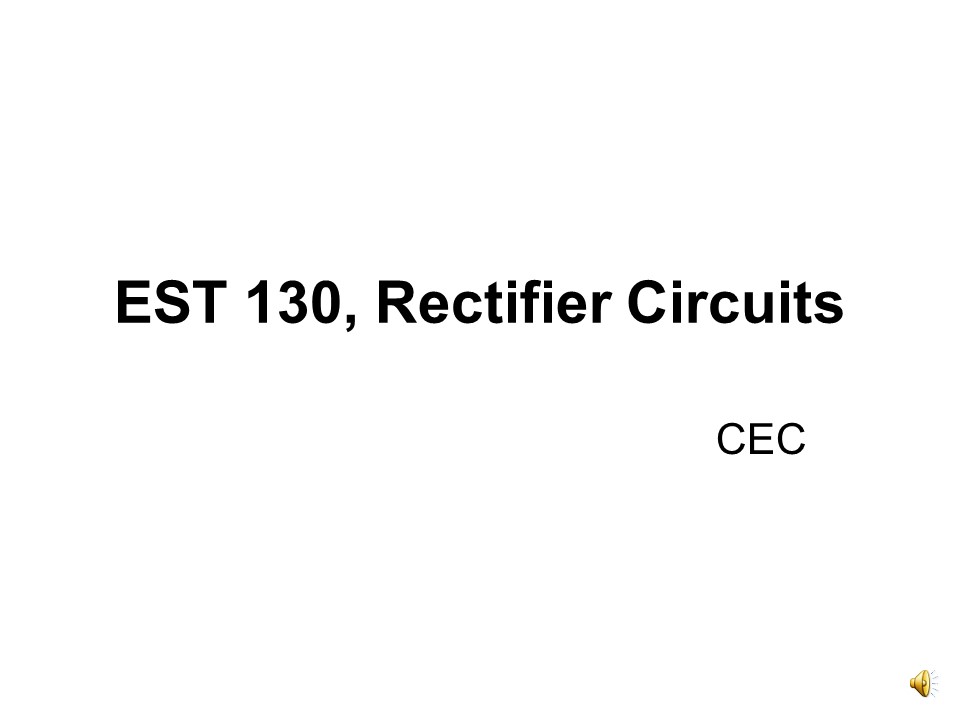Rectifier Circuits - PowerPoint PPT Presentation
Title:
Rectifier Circuits
Description:
The attached narrated power point presentation attempts to explain the construction and working principle of rectifier circuits using PN junction diodes. – PowerPoint PPT presentation
Number of Views:23
Title: Rectifier Circuits
1
EST 130, Rectifier Circuits
- CEC
2
Contents
- Regulated Power Supply.
- Rectifier Circuits.
- Half Wave Rectifier.
- Centre Tapped Full Wave Rectifier.
- Bridge Rectifier.
- Rectifier Parameters.
- Filtering and Regulation.
3
Regulated Power Supply
- To convert power line ac voltage to the required
dc value. - Diodes are unidirectional devices, allows current
to flow through them in only one direction. - Rectifier diodes convert bidirectional ac line
voltage to unidirectional pulsating dc voltage. - Mostly silicon diodes used.
4
Block Diagram of Regulated Power Supply
5
Step Down Transformer
Primary
Secondary
6
Use of Diodes
- Unidirectional property conducts when forward
biased, off when reverse biased. - Silicon diodes used reverse current small of
the order of nanoamperes. - Cut in voltage of 0.6 V for silicon diodes.
- Germanium diodes cut in voltage lt 0.3 V, but not
used for rectification larger reverse currents
of the order of microamperes.
7
Unidirectional Property of Diodes
8
Types of Rectifiers
- Half Wave Rectifiers only one diode.
- Centre Tapped Full Wave Rectifiers two diodes.
- Bridge Rectifier four diodes in bridge
configuration.
9
(No Transcript)
10
Half Wave Rectifier
D1 Forward Biased during positive half cycle
Only Positive Half Cycle
11
Half Wave Rectifier
12
13
14
Capacitor Filter
Electrolytic Capacitors as filters
15
Half Wave Rectifier
Diode Reversed
Only Negative Half Cycle
16
Centre Tapped Full Wave Rectifier
Cathodes connected together
Top of the Secondary
IL
Bottom of the Secondary
Centre Tap
17
Centre Tapped Full Wave Rectifier
- When the top of the secondary is positive, D1 is
forward-biased, causing current to flow in the
load, RL, D2 is off, being reverse-biased. - When the top of the secondary is negative, D2 is
forward-biased, causing current to flow in the
load, RL, D1 is off, being reverse-biased. - Direction of current through RL the same for both
half-cycles of secondary voltage.
18
Full Wave Rectifier
IL
19
IL
20
Full Wave Rectifier
21
Capacitor Filter
Time Constant RLC increased when C is increased,
C discharges more slowly, ripple reduces.
22
Centre Tapped Full Wave Rectifier
Centre Tap
23
Full Wave Bridge Rectifier
D2, D3 Forward Biased during positive half cycle.
IL
D1, D4 Forward Biased during negative half cycle.
Current Flow through RL in the same direction.
24
Bridge Rectifier
D2, D3 Forward Biased
IL
25
Bridge Rectifier
D1, D4 Forward Biased
IL
26
Bridge Rectifier
27
Bridge Rectifier
28
Bridge Rectifier Modules
29
Frequency of Output Waveform
- One cycle includes the variations between two
successive points having the same value and
varying in the same direction. - Half Wave Rectifier fout fin
- Full Wave Rectifier fout 2fin
- Bridge Rectifier fout 2fin
- where fin frequency of the input waveform.
30
Time Constant RLC increased when C is increased,
C discharges more slowly, ripple reduces.
31
(No Transcript)
32
(No Transcript)
33
34
Comparison
35
Filters and Regulators
- Filters smoothen pulsating DC.
- Can be Capacitive Filter, Inductive Filter and
CRC Filter. - Use of Zener diode regulators, Transistor based
voltage regulators or IC regulators. - Zener diodes used for voltage regulation.
- IC Regulators positive (IC 78xx) and negative
(IC 79xx) voltage regulators.
36
Zener Diode Regulator
37
Transistor Voltage Regulator
38
Voltage Regulator ICs
39
IC Regulated Power Supply
Step Down Transformer
Voltage Regulator
Output
Rectifier and Filter
40
Thank You































